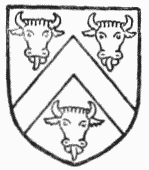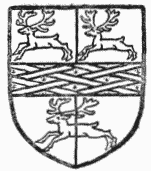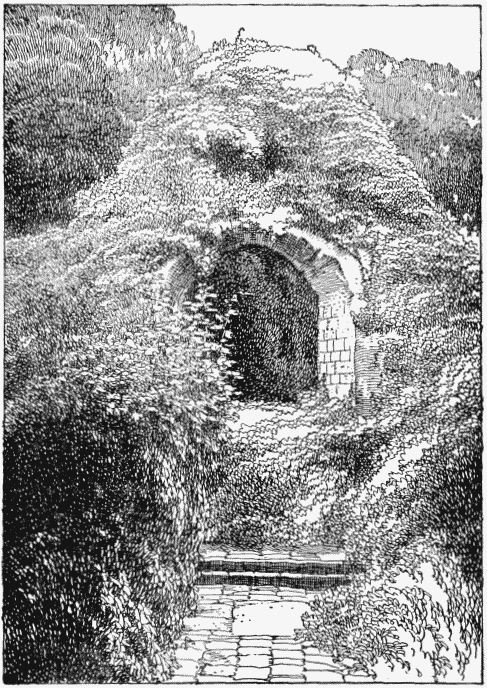A History of the County of Berkshire: Volume 3. Originally published by Victoria County History, London, 1923.
This free content was digitised by double rekeying. All rights reserved.
'Parishes: Arborfield', in A History of the County of Berkshire: Volume 3, (London, 1923) pp. 200-203. British History Online https://www.british-history.ac.uk/vch/berks/vol3/pp200-203 [accessed 19 April 2024]
In this section
ARBORFIELD
Edburgefeld, Erburgefeld (xii cent.); Hereburgefeld, Erbelgiresfeld (xiii cent.).
The parish of Arborfield has an area of 1,468½ acres, of which nearly two-thirds are arable land and about one-third permanent grass. There is only a small amount of woods and plantations. (fn. 1) The soil is clay and gravel with a subsoil of London clay and the principal crops are wheat and barley. The average height of most of the parish is 200 ft. above the ordnance datum, the highest point (229 ft.) being reached near Arborfield Cross, from which there is a fall to about 140 ft. in the north-west of the parish, where the River Loddon forms its boundary.

Arborfield Hall
At Arborfield Cross six roads meet, of which one runs north to join the Reading road, a second leads west across the River Loddon to Shinfield, a third goes south-west to Swallowfield, a fourth south to Finchampstead, a fifth south-east to Barkham, and the sixth is a grass lane which runs by a winding course to East Heath. The nearest railway station is Sindlesham Halt.
The ruins of the old church adjoin Arborfield Hall near the north-west border of the parish, but the village lies on the road to the south-east at Arborfield Cross (Alfeldecrouch, Aldefeldecrosse, Awfield Cross), partly in the liberty of Newland in Hurst parish. The village is mostly composed of red brick cottages with slate or tiled roofs; there are, however, a few cottages of timber with brick filling and one or two with thatched roofs. The modern church stands to the north of Arborfield Cross. Arborfield Hall, the seat of Mrs. Hargreaves, is a modern gabled building of brick and stone built by George Pelsant Dawson and enlarged by Sir John Conroy and Captain Thomas Hargreaves (see manor), but the stables and laundry belonging to it formerly constituted part of the old manor-house, much of which was pulled down by Mr. George Dawson. The old stables and laundry form a rectangular building of red brick two stories in height with a gabled roof along its whole length; the windows of the lower story have modern wood frames, but the first floor is lighted on the west by small elliptical openings; in the east face the lights have either been modernized or covered by the later additions erected against it. The cornice is of moulded brick and the parapet is plain; the date 1654 is carved on the west front. The south gable end has two oval windows and a moulded brick coping. The old manor-house is described in detail in Miss Mitford's Our Village as the 'old house at Aberlegh.' (fn. 2) It is said to have been designed by Thorpe, and, if this is so, the remaining portion must be an addition to the original house.
Arborfield Grange stands in small but picturesque grounds west of Arborfield Cross. It was formerly the property of Sir John Conroy, bart., whose executors sold it to Capt. S. H. Rickman. R. N., J.P.
Arborfield Court is a new house built by Mrs. Bruce. When the foundations were being dug two burial urns were discovered 10 ft. below the ground.
At Kennys Farm, in the south of the parish, are two sides of a homestead moat which appears to have been square. (fn. 3) Whitehall Farm, in the south-east of the parish, occurs in the 16th century as the farm or capital messuage of Wyffolde or Whytehall. A Chancery suit for the recovery of the deeds of a lease of the farm made by Frances Kemp (who is said to have bought the estate from Henry Hynde of Finchampstead) was brought by Robert Atkynson, then of Whitehall, against a certain John Temple in 1571. (fn. 4)
There is a Congregational chapel in the parish, built in 1899.
Place-names occurring in Arborfield are: Reynoldestrete, (fn. 5) Useres Hayes, (fn. 6) Corversers, Downemilnelande, Vannhowse, Shanke White, Whitesmore and Colerymes. (fn. 7)
MANOR
The manor of ARBORFIELD is not mentioned by name in the Domesday Survey, and at that date probably formed part of the manor of Sonning, held by the Bishop of Salisbury. Subinfeudation of Arborfield was apparently made later, for at the beginning of the 13th century Richard Bullock held a quarter and a twentieth part of a fee there of the bishop. (fn. 8) He was the successor, apparently, of Osmund Bullock, who was patron of the church towards the end of the 12th century. (fn. 9) Richard was succeeded by Gilbert Bullock, who was holding the manor in 1254, (fn. 10) and who or whose son Gilbert was living in the reign of Edward I. (fn. 11) Robert Bullock was lord in 1331, (fn. 12) and in 1341 settled the manor on his son Robert and the latter's wife Joan Drokensford. (fn. 13) Robert Bullock, either the father or the son, was convicted of perjury and forfeited the estate, but was pardoned by the king in 1345. (fn. 14) Robert Bullock the younger died before 1365, when 'Robert Bullock tertius' made a grant of land in Arborfield. (fn. 15) A Robert Bullock was sheriff in 1384 (fn. 16) and 1391. (fn. 17) It would seem he died in 1405. (fn. 18) In 1407 Margaret widow of Robert Bullock and Margaret his daughter and heir, then wife of John Hertington, conveyed the manor to Laurence Dru, (fn. 19) from whom it descended to Thomas Dry of Seagry, Wiltshire, who in 1421 sold it to Thomas Bullock (fn. 20) and his wife Alice. (fn. 21) The manor continued in the hands of the Bullock family and descended to Thomas Bullock, (fn. 22) who by will of 1557, proved in 1558, left ornaments and vestments to Arborfield Church. His wife Agnes, by a provision of his will, was to have the upper parlour in the manor-house of Arborfield, the chamber over the same and 'Jaks chamber' and '2 butteres next the parlour, the old dyhouse for her kitchen.' If she did not like Arborfield she was to have the farm of Barkham. (fn. 23) Richard son of Thomas, who died in 1570, desired that his body should be buried in the chancel of Arborfield Church next to the tomb of Robert Bullock. (fn. 24) He was succeeded by his son Thomas, who in 1589 sold Arborfield and Barkham to Edmund Standen. (fn. 25)

Bullock. Gules a cheveron between three bulls' heads argent having their horns or.
In 1609 Sir Henry Neville wrote to Sir Ralph Winwood, who seems to have been negotiating for the purchase of Arborfield, 'I am sorry you are prevented in the purchase of Arborfield, I despair of any other near me that will be worthy of you.' (fn. 26) The purchase, however, did not take place.
In 1639 the manor was held by William Ball or Bennet and his wife Margaret, (fn. 27) possibly as dower of the latter, for the Standen family continued to hold it. Edmund Standen was succeeded by his son William, who died in 1639. (fn. 28) William Standen, apparently grandson of the latter, was dealing with the manor in 1678 (fn. 29) and Edward, his son, in 1700. (fn. 30) Edward Standen died in 1707 and was succeeded by his son Edward, who settled it in 1726. (fn. 31) He was the last male heir of the family and is the person alluded to in the ballad of 'Molly Mogg of the Rose.' On his death in 1730 he was succeeded by his mother's half-brother Richard Aldworth, then a minor. The manor was sold by the latter's guardian to Pelsant Reeves, (fn. 32) whose son John Reeves was the owner in 1806. (fn. 33) This property devolved upon Reeves's daughter Elmira wife of George Dawson of Osgodby Hall, Yorkshire, at her father's death in 1814. (fn. 34) Their son George Pelsant Dawson sold the manor to Sir Charles Russell, bart., in whose family it has since remained (see Swallowfield), and the manor-house and park to Sir John Conroy, bart., in 1842. After Sir John's death the latter were bought by Mr. John Hargreaves in 1855 for his son Thomas. (fn. 35) Captain Thomas Hargreaves died in 1891, his heir being his second son Mr. John Reginald Hargreaves, whose mother Mrs. Hargreaves now resides at Arborfield.

Hargreaves. Quarterly or and vert a fesse ermine fretty gules between three running harts countercoloured.
There was a fishery in the waters of Arborfield appurtenant to the manor, which is mentioned in 1589 and later. (fn. 36) Rights of fishing were also held by others than the lord of the manor. (fn. 37)
The park of Arborfield is also mentioned in conveyances. (fn. 38)
CHURCH
The church of ST. BARTHOLOMEW is a small building erected in 1863, mainly at the expense of Sir William Brown, bart., and consists of an apsidal chancel with a north vestry, and an aisleless nave with a west tower and a south porch.

Ruins of Old Church, Arborfield
The walls are of flint with stone dressings and the tower is of three stages with a stone octagonal spire. On the wall by the south doorway of the nave is a brass which came from the old church. The inscription commemorates Thomas Howard, who died in 1643, Anne his wife, and Frances 'there onely child.' The churchyard, which contains several large elm trees, is entered on the south side by a lych-gate.
There is a peal of six bells, the first five of which came from the old church, now in ruins. The treble, probably a 14th-century bell, bears the stamp of the Wokingham-Reading-London foundry, a trefoil, lion's face, and a coin (fn. 39); the second was cast by R. Catlin, 1743; the third bears the churchwardens' names and the date 1653; the fourth has the black-letter inscription 'Pryase ye the lorde,' with a coin between the beginning and ending of the sentence, and below this the initials of Joseph Carter with the date 1589, while between the initials is a shield on which is a bell between the letters R.M.; the fifth is inscribed 'Love God 1639'; the sixth was cast by John Warner & Sons, 1862.
The plate consists of two patens inscribed, 'Richardus Hayes hujus ecclesiae Rector, A.D. 1793,' a chalice, 1849, a flagon, 1886, and a pewter flagon and paten preserved at the hall.
The registers previous to 1812 are as follows: (i) mixed entries 1707 to 1739; (ii) 1739 to 1812; (iii) marriages only from 1756 to 1812.
The old church, also dedicated in honour of ST. BARTHOLOMEW, stood on the west of the present one near Arborfield Hall. Owing to its bad state of repair the roof was taken off in 1863, and the bare ruined walls alone remain. There is a sandstone piscina and three sedilia, and an aumbry also exists beneath the ivy. When the roof was removed and the later coatings of plaster were stripped from the walls they were found to be covered with painted figure subjects and geometrical and masonry patterns. Some encaustic tiles were also discovered. The old font, which is of wood, is preserved at the hall. On the floor are two stone slabs, one plain, of coffin shape, and the other rectangular, on which are traces of an inscription. Part of the south wall of these ruins forms the north wall of a small mortuary chapel which contains tablets and monuments to the Conroy, Standen, Hargreaves and Dawson families. A fine marble tomb with beautifully carved figures commemorates William Standen, who died in 1639, his wife Maria daughter of Samuel Backhouse of Swallowfield, and a child who died in infancy. An inscription states that the monument was restored by Sir John Conroy in 1843.
ADVOWSON
The church of Arborfield was originally a chapel of Sonning, and about 1190 Jordan, Dean of Salisbury, instituted a certain John, a clerk, at the presentation of Osmund Bullock. (fn. 40) This John would seem to have still been holding the chapel in the early years of Henry III and was also apparently at that time parson of Barkham. The ordinary service may have been done by the curate (capellanus annuus). At this time (in 1220) the chapel was still of wood and quite ruinous. (fn. 41) The stipendiary chaplains were for the most part illiterate, and in 1222 an old priest of Reading, in the house of Richard Bullock, who was serving Arborfield chapel, was found not to know a complete (integrum) word of either the Gospel or Canon of the Mass and forbidden to officiate. (fn. 42) The advowson followed the descent of the manor until the sale of the latter on the death of Edward Standen in 1730, (fn. 43) when the advowson was reserved to his heir Richard Aldworth (afterwards Richard 'Neville Aldworth), who was then a minor. It must have been leased out for some time, since Elizabeth Waterman presented in 1739 and Richard Hayes in 1755. (fn. 44) In 1793 Richard Aldworth Neville was succeeded by his son Richard Aldworth Neville, who made the presentation in 1797, and succeeding his cousin as Lord Braybrooke in this year, held the patronage until his death in 1825. (fn. 45) It was then inherited by his successors in the title, viz., his son Richard and his grandsons Richard and Charles. It was bought in 1880 by Mrs. Hargreaves, the present patron. (fn. 46)
The rectorial tithes or a part of them seem to have been payable to Sonning in 1535. (fn. 47) Later the church was always presented to as a rectory. (fn. 48)
CHARITIES
This parish is entitled to nominate an inmate to Lucas Hospital (see under Wokingham).
The parish property consists of four cottages at Lower Arborfield, two cottages at Arborfield Cross, and £205 18s. 5d. consols in the names of the guardians of the Wokingham Union, arising from the sale in or about 1845 of three cottages adjoining the Church Piddle. The annual income, amounting to £19 10s., is applied, after providing for repairs, in relief of the rates.
The School. The original school premises, comprised in deed, 1840, were sold in 1874. The present school, comprised in deed, 1871, was erected at a cost of £1,200, the greater part of which was contributed by the late Mr. John Walter. The school has been recently enlarged and is also available for poor children belonging to the parish of Barkham and the ecclesiastical district of Newland.
